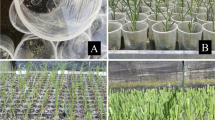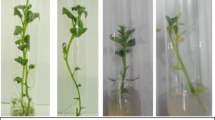Abstract
Embryo-derived calli of four rice varieties cultivated at high altitude in Burundi — Facagro 57, Facagro 76, Kirundo 3 and Kirundo 9 — were submitted to different temperature regimes. The percentage of regenerating calli greatly varied depending on variety, length of culture and callus temperature treatment. The reduction of regeneration percentages induced by low temperature was more pronounced in the more sensitive varieties. Regenerated plants (R0) and their progenies in R1, R2 and R3 were cold-screened together with control plants. In all varieties, significantly higher survival rates were obtained in R3 with in vitro plants than with control plants. Such chilling tolerance improvement was not obtained following a massal selection applied during 3 successive generations onto the control plants. In vitro plants regenerated from calli cultivated either at 25 °C, either at 4 °C, were cultivated at different altitudes in Burundi during two successive generations. For most observed traits, the in vitro plants were characterized by lower means, larger variation and higher maximum values than the control plants. The most chilling-tolerant somaclonal families were most usually characterized by extensive differences in fatty acid composition, chilling-induced electrolyte leakage and chlorophyll fluorescence, compared to the varieties they derived from.
Similar content being viewed by others
References
Adkins, S.W., T. Shiraishi, J.A. McComb, S. Ratanopol, T. Kupkanchanakul, L.J. Armstrong & A.L. Schultz, 1990. Somaclonal variation in rice — Submergence tolerance and other agronomic characters. Physiol. Plant. 80: 647–654.
Adkins, S.W., R. Kunanuvatchaidach & I.D. Godwin, 1995. Somaclonal variation in rice — Drought tolerance and other agronomic characters. Aust. J. Bot. 43: 201–209.
Bertin, P., J.-M. Kinet & J. Bouharmont, 1995. Heritable chilling tolerance improvement in rice through somaclonal variation and cell line selection. Aust. J. Bot. 44: 91–105.
Bertin, P., J.-P. Busogoro, J.-P. Tilquin, J.-M. Kinet & J. Bouharmont, 1996a. Field evaluation and selection of rice somaclonal variants at different altitudes. Plant Breeding (In press).
Bertin, P., J.-M. Kinet & J. Bouharmont, 1996b. Evaluation of chilling sensitivity in different rice varieties. Relationship between screening procedures applied during germination and vegetative growth. Euphytica 89: 201–210.
Breiman, A., T. Felsenburg & E. Galun, 1989. Is NOR region variability in wheat invariably caused by tissue culture? Theor. Appl. Genet. 77: 809–814.
Buiatti, M., 1989. Use of cell and tissue cultures for mutation breeding. Vortr. Pflanzenzücht G. 16: 179–200.
Butler, W.L., 1978. Energy distribution in the photochemical apparatus of photosynthesis. Annu. Rev. Plant Physiol. 29: 345–378.
Butler, W.L. & M. Kitajima, 1975. Fluorescence quenching in photosystem II of chloroplasts. Biochim. Biophys. Acta 376: 116–125.
Chang, T.T. & H.I. Oka, 1976. Genetic variousness in the climatic adaptation of rice cultivars. In: Climate and Rice. pp. 87–111. International Rice Research Institute, Manila, Philippines.
Dekeyser, A., J. Lhoest, L. Van Caneghem & J. Bouharmont, 1987. Selection and characterization of cold-and salt-tolerant rice varieties by in vitro culture techniques. Med. Fac. Landbouww. Univ. Gent 52: 1439–1448.
Dix, P.J., 1977. Chilling resistance is not transmitted sexually in plants regenerated from Nicotiana sylvestris cell lines. Z. Pflanzenphysiol. 84: 223–226.
Dix, P.J. & H. E. Street, 1976. Selection of plant cell lines with enhanced chilling resistance. Ann. Bot. 40: 903–910.
Dörffling, K., H. Dörffling & G. Lesselich, 1993. In vitro-selection and regeneration of hydroxyproline-resistant lines of winter wheat with increased proline content and increased frost tolerance. J. Plant Physiol. 142: 222–225.
Evans, D. A., 1989. Somaclonal variation — Genetic basis and breeding applications. Trends in Genetics 5(2): 46–50.
Futsuhara, Y. & K. Toriyama, 1966. Genetic studies on cool tolerance in rice. III. Linkage relations between genes controlling cold tolerance and marker genes Nagao and Takahasi. Jpn. J. Breed. 16: 231–242.
Futsuhara, Y. & K. Toriyama, 1969. Genetic studies on cool tolerance in rice. IV. Direct and indirect effects of selection and cold tolerance. Jpn. J. Breed. 19: 286–292.
Futsuhara, Y. & K. Toriyama, 1971. Genetic studies on cool tolerance in rice. V. Effectiveness of individual and line selections for cool tolerance. Jpn. J. Breed. 21: 181–188.
Galiba, G. & J. Sutka, 1989. Frost resistance of somaclones derived from Triticum aestivum L. winter wheat calli. Plant Breeding 102: 101–104.
Huang, L.K., C.B. Osmond & I. Terashima, 1989. Chilling injury in mature leaves of rice. II. Varietal differences in the response to interaction between low temperature and light measured by chlorophyll fluorescence at 77K and the quantum yield of photosynthesis. Aust. J. Plant Physiol. 16: 339–352.
Kaw, R.N. & G.S. Khush, 1986. Combining ability for low temperature tolerance in rice. In: Rice genetics. pp. 593–612. International Rice Research Institute, Manila, Philippines.
Kendall, E.J., J.A. Qureshi, K.K. Kartha, N. Leung, N. Chevrier, K. Caswell & T.H.H. Chen, 1990. Regeneration of freezing-tolerant spring wheat (Triticum aestivum L.) plants from cryoselected callus. Plant Physiol. 94: 1756–1762.
Kitajima, M. & W.L. Butler, 1975. Quenching of chlorophyll fluorescence and primary photochemistry in chloroplasts by dibromothymoquinone. Biochim. Biophys. Acta 376: 105–115.
Kucherenko, L.A., 1991. Rice improvement through tissue culture in the USSR. In: Y.P.S. Bajaj (Ed.). Biotechnology in Agriculture and Forestry. 14. Rice. pp. 575–590. Springer-Verlag, Berlin, Heidelberg.
Larkin, P.J. & W.R. Scowcroft, 1981. Somaclonal variation — a novel source of variability from cell culture for plant improvement. Theor. Appl. Genet. 60: 197–214.
Lazar, M.D., T.H.H. Chen, L.V. Gusta & K.K. Kartha, 1988. Somaclonal variation for freezing tolerance in a population derived from Norstar winter wheat. Theor. Appl. Genet. 75: 480–484.
Lee, M., J.L. Geadelmann & R.L. Philips, 1988. Agronomic evaluation of inbred lines derived from tissue cultures of maize. Theor. Appl. Genet. 75: 841–849.
Li, C.C. & J.N. Rutger, 1980. Inheritance of cool-temperature seedling vigor in rice and its relationship with other agronomic characters. Crop Sci. 20: 295–298.
Majumder, M.K., D.V. Seshu & V.V. Shenoy, 1989. Implication of fatty acids and seed dormancy in a new screening procedure for cold tolerance in rice. Crop Sci. 29: 1298–1304.
Miller, D.R, R.M. Waskom, M.A. Brick & P.L. Chapman, 1991. Transferring in vitro technology to the field. Bio/Technology 9: 143–146.
Mitra J. & F. Steward, 1961. Growth induction in cultures of Haplopappus gracilis. II. The behaviour of the nucleus. Am. J. Bot. 48: 358–368.
Morrish, F.M., W.W. Hanna & I.K. Vasil, 1990. The expression and perpetuation of inherent somatic variation in regenerants from embryogenic cultures of Pennisetum glaucum (L.) R. Br. (pearl millet). Theor. Appl. Genet. 80: 409–416.
Nagamine, T., 1991. Genic control of tolerance to chilling injury at seedling stage in rice, Oryza sativa L. Jpn. J. Breed. 41: 35–40.
Nagamine, T. & M. Nakagahra, 1990. Genetic variation of chilling injury at seedling stage in rice, Oryza sativa L. Jpn. J. Breed. 40: 449–455.
Ogura, H., J. Kyozuka, Y. Hayashi, T. Koba & K. Shimamoto, 1987. Field performance and cytology of protoplast-derived rice (Oryza sativa): high yield and low degree of variation of four japonica cultivars. Theor. Appl. Genet. 74: 670–676.
Ogura, H. & K. Shimamoto, 1991. Field performance of protoplast-derived rice plants and the release of a new variety. In: Y.P.S. Bajaj (Ed.). Biotechnology in Agriculture and Forestry. 14. Rice. pp. 269–282. Springer-Verlag, Berlin, Heidelberg.
Sasaki, T., 1974. Studies on germination ability under low temperature condition of rice varieties. Kamikawa Agric. Exp. Sta., Hokkaido 24: 1–90.
Shahi, B.B. & G.S. Khush, 1986. Genetic analysis of cold tolerance in rice. In: Rice genetics. pp. 429–435. International Rice Research Institute, Manila, Philippines.
Smillie, R.M., S.E. Hetherington, J. He & R. Nott, 1988. Photoinhibition at chilling temperatures. Aust. J. Plant Physiol. 15: 207–222.
Sthapit, B.R., J.R. Witcombe & J.M. Wilson, 1995. Methods of selection for chilling tolerance in Nepalese rice by chlorophyll fluorescence analysis. Crop Sci. 35: 90–94.
Sun, Z.-X., L.-H. Sun, & L.-H. Shu, 1991. Utilization of somaclonal variation in rice breeding. In: Y.P.S. Bajaj (Ed.). Biotechnology in Agriculture and Forestry. 14. Rice. pp. 329–346. Springer-Verlag, Berlin, Heidelberg.
Sun, Z.-X., C.-Z. Zhao, K.-L. Zheng, X.-F. Qi & Y.-P. Fu, 1983. Somaclonal genetics of rice, Oryza sativa L. Theor. Appl. Genet. 67: 67–73.
Toriyama, K & Y. Futsuhara, 1960. Genetic studies on cool tolerance in rice. I. Inheritance of cool tolerance. Jpn. J. Breed. 10: 143–152.
Van Sint Jan, V., N. Skali Senhaji, M. Amssa, P. Bertin, S. Lutts & J. Bouharmont, 1991: In vitro selection for stress tolerance in rice. Vortr. Pflanzenzüchtg. 20: 146–153.
Waskom, R.M., D.R. Miller, G.E. Hanning, R.R. Duncan, R.L. Voigt & M.W. Nabors, 1990. Field evaluation of tissue culture derived sorghum for increased tolerance to acid soils and drought stress. Can. J. Plant Sci. 70: 997–1004.
Wersuhn, G., 1989. Obtaining mutants from cell cultures. Plant Breeding 102: 1–9.
Zhang, M. & C.B. Rajashekar, 1994. Selection of cold tolerant cells of grapes in suspension culture. Plant Sci. 97: 69–74.
Author information
Authors and Affiliations
Rights and permissions
About this article
Cite this article
Bertin, P., Bouharmont, J. Use of somaclonal variation and in vitro selection for chilling tolerance improvement in rice. Euphytica 96, 135–142 (1997). https://doi.org/10.1023/A:1002926421430
Issue Date:
DOI: https://doi.org/10.1023/A:1002926421430




